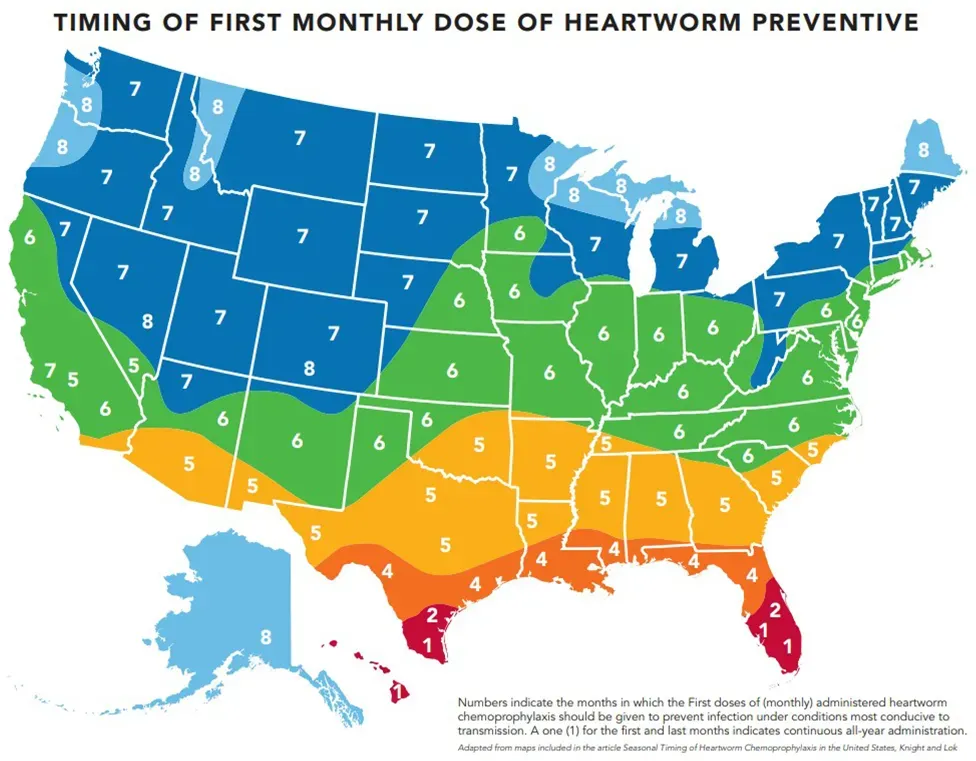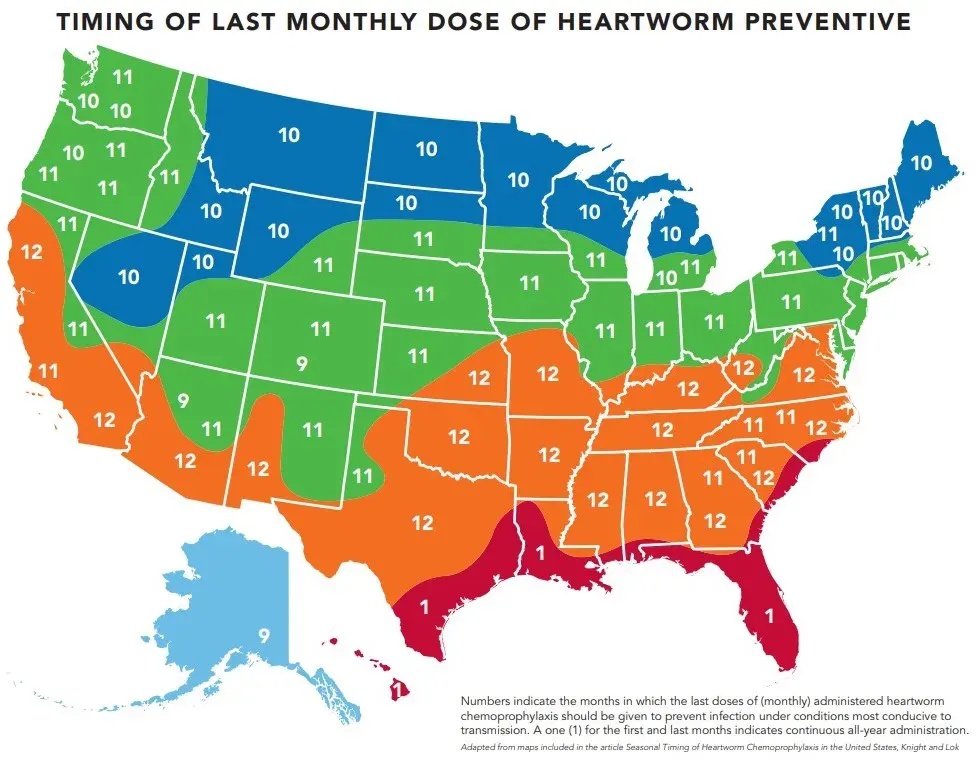Considering Heartworm Defense? Avoid This Serious Mistake
There's a good chance your vet has recommended year-round heartworm prevention for your dog. Is it really necessary? Are there downsides? Chemical pesticides with the potential for toxicity, heartworm preventive usage must be carefully evaluated. What you need to know before proceeding.

STORY AT-A-GLANCE
- It’s important to assess your pet’s actual risk of acquiring heartworms based primarily on where you live, which dictates the mosquito population
- Far from harmless, heartworm preventives are chemical pesticides with the potential for toxicity; in addition, there is a growing problem of heartworm resistance to preventives
- If you live in an area where mosquitoes are a problem, it’s important to work with your integrative veterinarian to develop a sensible preventive protocol to keep your pet safe and healthy
- A heartworm test should always be given before beginning any preventive treatment
Editor's Note: This article is a reprint. It was originally published October 21, 2018.
When it comes to intelligently assessing the risks associated with heartworm disease, where you live with your pet is the most important consideration. Unfortunately, there's no shortage of advocates of year-round heartworm prevention for all dogs everywhere, and they justify their position by pointing out that heartworm disease has been diagnosed in all 50 states.
This leads pet parents to make an incorrect assumption about the prevalence of heartworm disease in the U.S. While it may be true that at least 1 dog in all 50 states has been affected, it does not mean heartworm disease is a significant threat in every state.
According to the 2018 heartworm prevalence map published by the Companion Animal Parasite Council (CAPC), just 1 out of every 78 dogs in the U.S. — less than 1.3 percent — tests positive for heartworm. And despite the fact that cats aren't natural hosts for heartworm, year-round preventives are now being recommended for them as well.
In addition, in only 11 states are dogs considered at high risk for heartworm infection. These numbers have remained essentially unchanged since the first map was created in 2012. The 11 states are primarily in the southeast, where soaring temperatures and high humidity during the warmer months of the year provide an ideal environment for mosquitoes to thrive.
Insecticides Pose More Risk to Pets Than Heartworm Disease
The problem with conventional veterinary recommendations on heartworm prevention is that instead of focusing on the likelihood of infection and the risks versus benefits of administering a toxic chemical preventive every month of every year of an animal's life, the focus is on the scary, gross nature of a disease that occurs in only a small percentage of dogs.
Heartworm preventives are chemical insecticides with the potential for short- and long-term side effects damaging to your pet's health. In addition, heartworm "preventives" don't actually prevent the worms. They poison the larvae at the microfilaria (L1-L2) stage of development, causing them to die inside your pet's body.
In addition to concerns about the toxicity of these insecticides, there is also evidence of growing heartworm resistance to preventives. "Superbug" resistance is typically the result of overuse of certain classes of drugs, as in the case of antibiotics. Perhaps the traditional veterinary community is well-intentioned, but their approach seems manipulative to me. In addition, it assumes pet guardians aren't bright or attentive enough to figure out when it's appropriate to protect their dogs from mosquito bites.
Read This Before Considering Heartworm Treatment for Your Dog
Heartworms are a variety of roundworm (dirofilaria immitis) and are spread by mosquitoes. Dogs can only acquire heartworm disease through infected mosquitoes. They can't get it from other dogs or other animals, from dog poop or from their mothers while in the womb or through nursing. Only certain mosquitoes can transmit heartworm to your dog. These mosquitoes must meet certain precise criteria, including:
- They must be female
- They must be of a species that allows development of the worms in the cells of the body (not all species do)
- They must be of a species that feeds on mammals (not all do)
- They must have bitten an animal infected with stage 1 (L1) heartworms about two weeks prior, since approximately 14 days are necessary for the larvae from the other animal to develop to stage 3 (L3) inside the transmitting mosquito
This very specific mosquito must then bite your dog. When the larvae reach stage L4 to L5, which takes three to four months, under the right conditions they can travel via your dog's bloodstream to the lungs and heart. If your dog's immune system doesn't destroy the worms, they will reach maturity (L6), the adult stage, in which males can grow to 6 inches in length and females to 12. Two other critically important features in the transmission of heartworm are:
- The right temperature — During the time the heartworm larvae are developing from L1 to L3 inside an infected mosquito, which is approximately a two-week period, the temperature must not dip below 57 degrees F at any point in time. If it does, the maturation cycle is halted. Full development of the larvae requires the equivalent of a steady 24-hour daily temperature in excess of 64 degrees F for approximately one month.
- Humidity and standing water — Mosquitoes are a rarity in dry climates.
The bottom line: In order for your dog to develop heartworm disease, a number of things have to happen with near-perfect timing under a precise set of circumstances.
Regional Guidelines for Giving Heartworm Preventives
There are only a few areas in the U.S. in which giving a year-round heartworm preventive might be advisable — meaning the risk of infection may outweigh the risks associated with 24/7/365 exposure to a chemical insecticide. Those areas are in south Texas, south Florida and a few other locations along the Gulf Coast.
The rest of the U.S. ranges from three to seven months of high exposure risk. The majority of states are at six months or less. If you're concerned your dog is at risk of a heartworm infection, in consultation with your integrative veterinarian, you can use the following maps to guide you in when to start and stop a heartworm preventive.


For example, if you live on the Gulf Coast in either Texas or Florida where mosquitoes are a problem, the map suggests you begin giving a preventive on day 1 of month 1 (January), and give it year-round. However, if you live in western Oregon or Washington, the map suggests you start dosing in July to August, and stop in October to November.
It's important to keep in mind that these maps are only one tool in your toolbox. Let's say you live in southern Nevada where mosquitoes are almost unheard of, yet the map suggests giving a preventive starting in May and continuing through the end of the year. If that doesn't make sense to you, use your common sense. Factor in your own knowledge and experience of the area in which you live when assessing your pet's risk.
How to Help Your Pet Avoid Heartworm Disease
If you live in an area of the U.S. where mosquitoes are common and you know your dog's risk of exposure to heartworm disease is significant, here are my recommendations for protecting your furry family member:
- If you don't live in a tick-endemic area (for example, if you live in North Dakota), with guidance from an integrative veterinarian, try using natural preventives like heartworm nosodes rather than chemicals. Make sure to do heartworm testing every three to four months (not annually), as natural heartworm preventives can't guarantee your pet will never acquire the disease.
It's important to note that since heartworms live in the bloodstream, natural GI (gastrointestinal) dewormers such as diatomaceous earth and anti-parasitic herbs (e.g., wormwood, pumpkin seed, black walnut tinctures) are not effective at killing larvae in the bloodstream. - Focus on keeping your pet's immune function robust by feeding a species-appropriate, nutritionally balanced, fresh food diet that helps bolster natural defenses. Unprocessed meats are rich in B vitamins (and a less allergenic option than offering brewer's yeast). Also, specific anti-parasitic foods such as fresh garlic can be added in small quantities to provide additional support.
- If your dog's kidneys and liver are healthy, try using a chemical preventive at the lowest effective dosage. This could mean having the Ivermectin compounded if necessary for dogs weighing in at the low end of dosing instructions. Give the treatment at six-week intervals rather than every four weeks, for the minimum number of months required during mosquito season.
- Avoid all-in-one chemical products that claim to get rid of multiple types of GI worms and external parasites as well. The goal is to use the least amount of chemical necessary that successfully treats heartworm. Adding other chemicals to the mix increases the toxic load your dog's body must contend with. Also avoid giving your pet a chemical flea/tick preventive during the same week.
- Follow up all heartworm medications with natural liver detox agents like milk thistle and SAMe for a week following chemical treatment, in consultation with your veterinarian.
- Always insist on a heartworm test before beginning any preventive treatment. If you live or spend time with your pet in areas where mosquitoes and other pests, especially ticks, are prevalent, ask your veterinarian for a SNAP-4Dx test or an Accuplex test, both of which check for Lyme disease, ehrlichiosis and anaplasmosis, along with heartworm.
I like to run the SNAP-4Dx every six months on dogs who spend a lot of time outdoors during warmer weather. The reason I do tests every six months is because parasites are becoming resistant to heartworm and flea/tick chemicals. The sooner we identify an infection in your pet, the sooner a protocol can be instituted to safely treat it with fewer long-term side effects.
If you live in the midwest or the east coast of the U.S., it's a good idea early in the year and at the end of pest season to check for these illnesses, which can be resistant to preventives and are relatively easy to treat and cure when they're identified before they create chronic disease.











